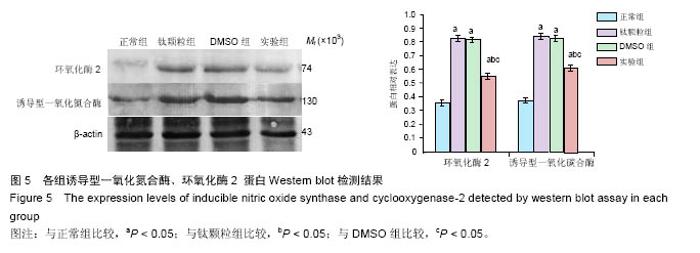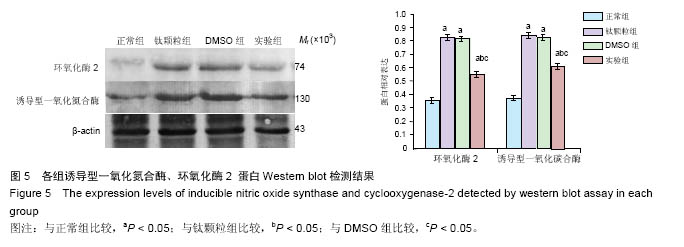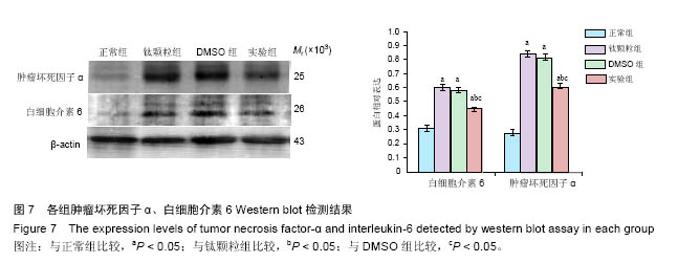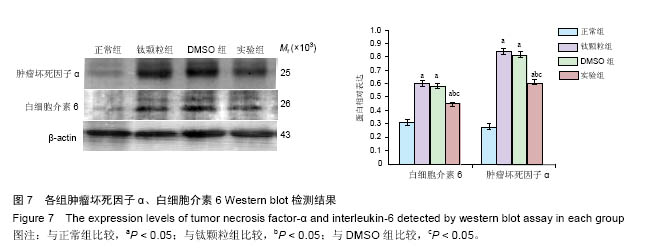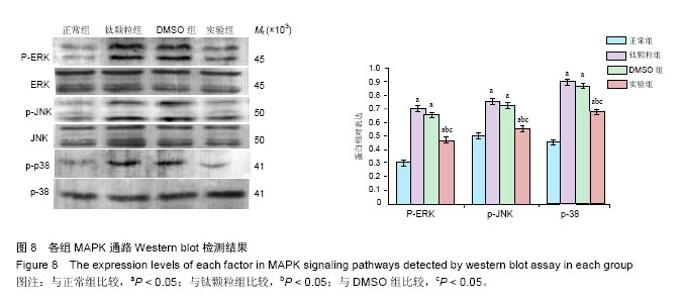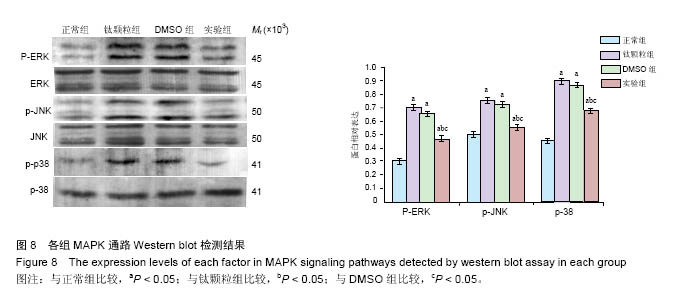Chinese Journal of Tissue Engineering Research ›› 2016, Vol. 20 ›› Issue (52): 7836-7843.doi: 10.3969/j.issn.2095-4344.2016.52.012
Previous Articles Next Articles
Ethyl linoleate inhibits inflammatory reaction induced by titanium particles and its mechanism
- 1Graduate School of Xuzhou Medical University, Xuzhou 221004, Jiangsu Province, China; 2Department of Spine Surgery, 3Department of Joint Surgery, Affiliated Hospital of Xuzhou Medical University, Xuzhou 221004, Jiangsu Province, China
-
Received:2016-09-25Online:2016-12-16Published:2016-12-16 -
Contact:Guo Kai-jin, Professor, Department of Spine Surgery, Affiliated Hospital of Xuzhou Medical University, Xuzhou 221004, Jiangsu Province, China -
About author:Liu Guo-dong, Studying for master’s degree, Graduate School of Xuzhou Medical University, Xuzhou 221004, Jiangsu Province, China -
Supported by:the Science Research Foundation of the Health Department, No. LW201004; the Science and Technology Project of Xuzhou, No. XM13B080
CLC Number:
Cite this article
Liu Guo-dong, Xin Bing, Huang Dong, Zheng Bai, Sun Bai-han, Guo Kai-jin.
share this article

2.1 实验动物数量分析 48只昆明小鼠均进入结果分析。 2.2 苏木伊红染色结果 正常小鼠背部皮肤组织真皮层中可见毛囊和皮脂腺细胞、毛囊陷窝等处未见炎性细胞浸润,皮下疏松结缔组织亦未见炎性细胞浸润,见图4A。与正常组比较,钛颗粒组小鼠背部皮肤真皮层毛囊陷窝处及皮下疏松结缔组织可见大量炎性细胞浸润及空泡坏死组织,见图4B。与正常组比较,DMSO组小鼠背部皮肤真皮层毛囊陷窝处及皮下疏松结缔组织也可见大量炎性细胞浸润及空泡坏死组织,所见基本和钛颗粒组相似,见图4C。实验组小鼠背部皮肤真皮层毛囊陷窝处及皮下疏松结缔组织炎性细胞的浸润较钛颗粒组和DMSO组明显减少,空泡坏死组织也有所减少,见图4D。"

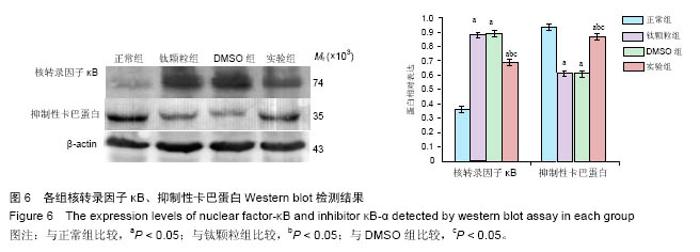
2.3.2 抑制性卡巴蛋白、NF-κB 在钛颗粒诱导小鼠背部气囊炎症模型中,NF-κB是激活诱导型一氧化氮合酶、环氧化酶2和细胞因子表达的重要调节,因此用免疫印迹法检测NF-κB、抑制性卡巴蛋白的表达变化。钛颗粒可以诱导NF-κB的大量表达,且在溶媒剂DMSO组其表达量不变,而在注入亚油酸乙酯14 d后,可观察到NF-κB的表达明显减少。在正常组中,抑制性卡巴蛋白大量表达;经钛颗粒诱导后,抑制性卡巴蛋白表达明显下降,DMSO组无明显变化;然而,与钛颗粒组比较,实验组抑制性卡巴蛋白表达显著升高,见图6。结果表明,经钛颗粒的刺激会加速抑制性卡巴蛋白磷酸化降解及与NF-κB的解离,而亚油酸乙酯则可抑制抑制性卡巴蛋白的磷酸化降解,使ⅠκB-α表达增高,进一步抑制NF-κB的激活。"
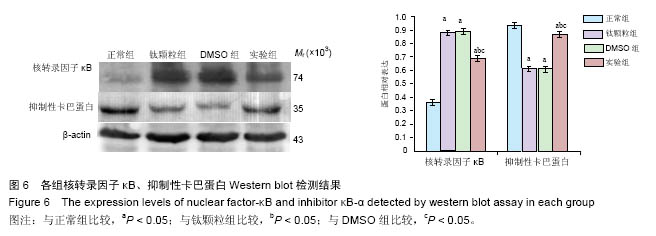
| [1]Shao H,Shen J,Wang M,et al.Icariin protects against titanium particle-induced osteolysis and inflammatory response in a mouse calvarial model.Biomaterials. 2015;60:92-99.[2]Johanson PE,Digas G,Herberts P,et al.Highly crosslinked polyethylene does not reduce aseptic loosening in cemented THA 10-year findings of a randomized study. Clin Orthop Relat Res. 2012;470: 3083-3093.[3]Dorr LD,Wan Z,Shahrdar C,et al.Clinical performance of a Durasul highly cross-linked polyethylene acetabular liner for total hip arthroplasty at five years.J Bone Joint Surg Am.2005;87:1816-1821.[4]Kurtz S,Ong K,Lau E,et al.Projections of primary and revision hip and knee arthroplasty in the United States from 2005 to 2030.J Bone Joint Surg Am. 2007;89: 780-785.[5]Lee YE,Park KS,Park EK,et al.Polycan suppresses osteoclast differentiation and titanium particle-induced osteolysis in mice.J Biomed Mater Res B Appl Biomater. 2015;104(6):1170-1175. [6]Jin S,Park JY,Hong JM,et al.Inhibitory effect of (-) -epigallocatechin gallate on titanium particle-induced TNF-alpha release and in vivo osteolysis.Exp Mol Med. 2011;43(7):411-418.[7]Wang W, Wu C, Tian B, et al. The inhibition of RANKL-induced osteoclastogenesis through the suppression of p38 signaling pathway by naringenin and attenuation of titanium-particle-induced osteolysis. International journal of molecular sciences. 2014;15: 21913-34.[8]Bi F,Shi Z,Zhou C,et al.Intermittent Administration of Parathyroid Hormone [1-34] Prevents Particle-Induced Periprosthetic Osteolysis in a Rat Model.PloS One. 2015;10:e0139793.[9]Park SY,Seetharaman R,Ko MJ,et al.Ethyl linoleate from garlic attenuates lipopolysaccharide-induced pro-inflammatory cytokine production by inducing heme oxygenase-1 in RAW264.7 cells.Int Immunopharmacol.2014;19:253-261.[10]Baeuerle PA.IkappaB-NF-kappaB structures: at the interface of inflammation control.Cell. 1998;95:729-731.[11]Lawrence T,Willoughby DA,Gilroy DW. Anti-inflammatory lipid mediators and insights into the resolution of inflammation.Nat Rev Immunol. 2002; 2(10):787-795.[12]Lv H,Ren W,Zheng Y,et al.Tenuigenin exhibits anti-inflammatory activity via inhibiting MAPK and NF-kappaB and inducing Nrf2/HO-1 signaling in macrophages. Food & function. 2015.[13]Becker S,Mundandhara S,Devlin RB,et al.Regulation of cytokine production in human alveolar macrophages and airway epithelial cells in response to ambient air pollution particles: further mechanistic studies.Toxicol Appl Pharmacol.2005;207:269-275.[14]Hungund BL,Zheng Z,Barkai AI.Turnover of ethyl-linoleate in rat plasma and its distribution in various organs.Alcohol Clin Exp Res. 1995;19(2): 374-377.[15]Fujii J,Niida S,Yasunaga Y,et al.Wear debris stimulates bone-resorbing factor expression in the fibroblasts and osteoblasts. Hip Int.2011;21:231-237.[16]Geng D,Wu J,Shao H,et al.Pharmaceutical inhibition of glycogen synthetase kinase 3 beta suppresses wear debris-induced osteolysis.Biomaterials.2015;69:12-21.[17]Liu X,Qu X,Wu C,et al.The effect of enoxacin on osteoclastogenesis and reduction of titanium particle-induced osteolysis via suppression of JNK signaling pathway. Biomaterials.2014;35:5721-5730.[18]Dobzyniak M,Fehring TK,Odum S.Early failure in total hip arthroplasty.Clin Orthop Relat Res. 2006;447: 76-78.[19]Mabilleau G,Pandit H,Jinnah RH,et al.Biological response to common surface bearings used in orthopaedics.J Surg Orthop Adv.2008;17(1):34-39.[20]Ingham E,Fisher J.Biological reactions to wear debris in total joint replacement. Proc Inst Mech Eng H.2000; 214(1):21-37.[21]Antonios JK,Yao Z,Li C,et al. Macrophage polarization in response to wear particles in vitro.Cell Mol Immunol. 2013;10(6):471-482.[22]Nich C,Takakubo Y,Pajarinen J,et al.Macrophages-Key cells in the response to wear debris from joint replacements.J Biomed Mater Res A.2013;101(10): 3033-3045.[23]Eteraf-Oskouei T,Allahyari S,Akbarzadeh- Atashkhosrow A, et al.Methanolic Extract of Ficus carica Linn. Leaves Exerts Antiangiogenesis Effects Based on the Rat Air Pouch Model of Inflammation. Evid Based Complement Alternat Med.2015;2015: 760405.[24]Colville-Nash PR,Scott DL.Angiogenesis and rheumatoid arthritis: pathogenic and therapeutic implications.Ann Rheum Dis.1992;51(7):919-925.[25]Lappas M,Permezel M,Georgiou HM,et al.Nuclear factor kappa B regulation of proinflammatory cytokines in human gestational tissues in vitro.Biol Reprod.2002; 67(2):668-673.[26]Murakami A,Ohigashi H.Targeting NOX,INOS and COX-2 in inflammatory cells: chemoprevention using food phytochemicals.Int J Cancer. 2007;121(11): 2357-2363.[27]Sturm A,Schulte C,Schatton R,et al.Transforming growth factor-beta and hepatocyte growth factor plasma levels in patients with inflammatory bowel disease.Eur J Gastroenterol Hepatol.2000;12(4): 445-450.[28]Surh YJ,Chun KS,Cha HH,et al.Molecular mechanisms underlying chemopreventive activities of anti-inflammatory phytochemicals: down-regulation of COX-2 and iNOS through suppression of NF-kappa B activation.Mutat Res.2001;480-481:243-268.[29]Goodman SB,Ma T,Spanogle J,et al.Effects of a p38 MAP kinase inhibitor on bone ingrowth and tissue differentiation in rabbit chambers.J Biomed Mater Res A.2007;8(2)1:310-316.[30]Goodman SB,Gibon E,Pajarinen J,et al.Novel biological strategies for treatment of wear particle-induced periprosthetic osteolysis of orthopaedic implants for joint replacement.J R Soc Interface.2014;11(93):20130962.[31]Deny A,Loiez C,Deken V,et al.Epidemiology of patients with MSSA versus MRSA infections of orthopedic implants: Retrospective study of 115 patients.Orthop Traumatol Surg Res.2016;102(7):919-923.[32]Zaborowska M,Tillander J,Brånemark R,et al.Biofilm formation and antimicrobial susceptibility of staphylococci and enterococci from osteomyelitis associated with percutaneous orthopaedic implants.J Biomed Mater Res B Appl Biomater.2016.doi: 10.1002/jbm.b.33803.[Epub ahead of print][33]Hallock K,Vaughn NH,Juliano P,et al.Metal Hypersensitivity and Orthopedic Implants: A Survey of Orthopedic Surgeons.Dermatitis.2016.[Epub ahead of print][34]Veronesi F,Giavaresi G,Fini M,et al.Osseointegration is improved by coating titanium implants with a nanostructured thin film with titanium carbide and titanium oxides clustered around graphitic carbon. Mater Sci Eng C Mater Biol Appl.2017;70(Pt 1): 264-271. [35]Zhao D,Witte F,Lu F,et al.Current status on clinical applications of magnesium-based orthopaedic implants: A review from clinical translational perspective. Biomaterials.2016;112:287-302. |
| [1] | Zhang Tongtong, Wang Zhonghua, Wen Jie, Song Yuxin, Liu Lin. Application of three-dimensional printing model in surgical resection and reconstruction of cervical tumor [J]. Chinese Journal of Tissue Engineering Research, 2021, 25(9): 1335-1339. |
| [2] | Geng Qiudong, Ge Haiya, Wang Heming, Li Nan. Role and mechanism of Guilu Erxianjiao in treatment of osteoarthritis based on network pharmacology [J]. Chinese Journal of Tissue Engineering Research, 2021, 25(8): 1229-1236. |
| [3] | Gu Xia, Zhao Min, Wang Pingyi, Li Yimei, Li Wenhua. Relationship between hypoxia inducible factor 1 alpha and hypoxia signaling pathway [J]. Chinese Journal of Tissue Engineering Research, 2021, 25(8): 1284-1289. |
| [4] | Shi Yangyang, Qin Yingfei, Wu Fuling, He Xiao, Zhang Xuejing. Pretreatment of placental mesenchymal stem cells to prevent bronchiolitis in mice [J]. Chinese Journal of Tissue Engineering Research, 2021, 25(7): 991-995. |
| [5] | Wang Zhengdong, Huang Na, Chen Jingxian, Zheng Zuobing, Hu Xinyu, Li Mei, Su Xiao, Su Xuesen, Yan Nan. Inhibitory effects of sodium butyrate on microglial activation and expression of inflammatory factors induced by fluorosis [J]. Chinese Journal of Tissue Engineering Research, 2021, 25(7): 1075-1080. |
| [6] | Xie Wenjia, Xia Tianjiao, Zhou Qingyun, Liu Yujia, Gu Xiaoping. Role of microglia-mediated neuronal injury in neurodegenerative diseases [J]. Chinese Journal of Tissue Engineering Research, 2021, 25(7): 1109-1115. |
| [7] | Zeng Yanhua, Hao Yanlei. In vitro culture and purification of Schwann cells: a systematic review [J]. Chinese Journal of Tissue Engineering Research, 2021, 25(7): 1135-1141. |
| [8] | Yang Yang, Yao Yu, Shen Xiaotian, Liu Jiajia, Xue Jianhua. Expression and significance of interleukin-21 in intervertebral disc degeneration [J]. Chinese Journal of Tissue Engineering Research, 2021, 25(5): 690-694. |
| [9] | Ma Binxiang, He Wanqing, Zhou Guangchao, Guan Yonglin. Triptolide improves motor dysfunction in rats following spinal cord injury [J]. Chinese Journal of Tissue Engineering Research, 2021, 25(5): 701-706. |
| [10] | Song Shan, Hu Fangyuan, Qiao Jun, Wang Jia, Zhang Shengxiao, Li Xiaofeng. An insight into biomarkers of osteoarthritis synovium based on bioinformatics [J]. Chinese Journal of Tissue Engineering Research, 2021, 25(5): 785-790. |
| [11] | Xu Dongzi, Zhang Ting, Ouyang Zhaolian. The global competitive situation of cardiac tissue engineering based on patent analysis [J]. Chinese Journal of Tissue Engineering Research, 2021, 25(5): 807-812. |
| [12] | Zhao Xiang, Wei Cuilan, Zhang Yeting. Neurogenesis and neuroinflammation under exercise: alteration and regulation [J]. Chinese Journal of Tissue Engineering Research, 2021, 25(5): 813-820. |
| [13] | Li Xingping, Xiao Dongqin, Zhao Qiao, Chen Shuo, Bai Yiguang, Liu Kang, Feng Gang, Duan Ke. Preparation and properties of copper-loaded antibacterial functional film on titanium surface [J]. Chinese Journal of Tissue Engineering Research, 2021, 25(4): 553-557. |
| [14] | Wu Zijian, Hu Zhaoduan, Xie Youqiong, Wang Feng, Li Jia, Li Bocun, Cai Guowei, Peng Rui. Three-dimensional printing technology and bone tissue engineering research: literature metrology and visual analysis of research hotspots [J]. Chinese Journal of Tissue Engineering Research, 2021, 25(4): 564-569. |
| [15] | Shi Xiaoxiu, Mao Shilong, Liu Yang, Ma Xingshuang, Luo Yanfeng. Comparison of tantalum and titanium (alloy) as orthopedic materials: physical and chemical indexes, antibacterial and osteogenic ability [J]. Chinese Journal of Tissue Engineering Research, 2021, 25(4): 593-599. |
| Viewed | ||||||
|
Full text |
|
|||||
|
Abstract |
|
|||||
